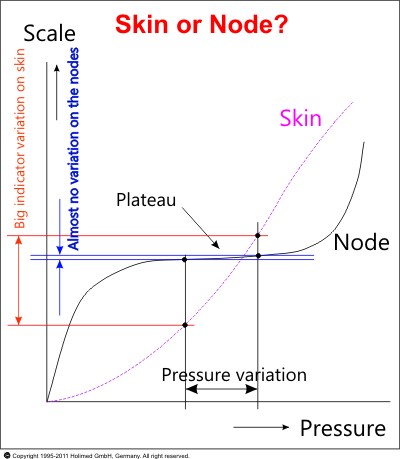EAV and bioresonance terminology
The measured values are independent of pressure: The EAV plateau effect.
EAV critics often emphasize that the tester can manipulate the measured values. This is simply not true and demonstrates the ignorance or inexperience underlying much criticism of EAV. The plateau effect describes a particular electromechanical property of the measurement points:
When, using a suitable measuring probe,
you stay within the working area of the point (the plateau),
the measured value will range widely
almost independently from the probe pressure.
The parabolic measurement tip is particularly suitable for evaluating the plateau effect. With the Kramer electrode, the effect is somewhat less significant due to its larger measuring area.
The diagram illustrates this:

It presents the scale value on the instrument as a function of the measured pressure. On this graph, the lower horizontal line depicts the pressure with which the probe is pressed on to the skin surface. At the left end of the line the pressure is zero; it increases toward the right. The vertical axis presents the scale value displayed on the instrument at that respective pressure. In the graph, you can see a thick solid black line and a dashed magenta line. The dashed line approximates the behavior of the skin. This line goes up steadily and its only practical limit is the pain threshold of the individual.
Just above the lower horizontal line you can see “pressure variation” and an arrow pointing in both directions. This pressure variation is important for the following reasons, because the indicator on the scale is being closely monitored,
- while starting from a given initial pressure,
- increasing the pressure up to a slightly higher value,
- then lowering the pressure again to the initial pressure
- repeating this process several times. Hence, the pressure can to a certain extent pulsate.
The initial and final pressure on the lower horizontal axis is extended with upward lines to the skin curve. From the two points at which each of these lines intersect with the curves, lines are drawn to the vertical axis on the left (scale). Here you can see the red vertical double arrow labelled “Big indicator variation at skin.”
In other words, if you vary the pressure of the probe on the skin significantly, that is, you reduce it and then increase it again, you will see a large change to the indicator on the scale. Given normal skin moisture, you may well see changes of more than +/- 10 scale divisions. This is a sign that you are measuring “normal” skin.
An EAV measuring point is different. This is portrayed as the solid black line labeled “Node.” You can see that this line
- rises rapidly at low pressure,
- then flattens out,
- remains on a so-called plateau over a wide pressure range,
- before finally rising again only at relatively high pressure, and then very quickly.
This last phase of rising rapidly at high pressure is usually perceived as unpleasant and even painful by the individual being measured
If, as before, the measuring pressure is changed and
- the auxiliary lines are extended to the solid black curve and
- lines are drawn from the points of intersection with the curve to the left towards the vertical axis,
- then they intersect with the axis at the two blue arrows that are directed against each other close to the text “Almost no variation on the node.”
If you are on the EAV measuring point and you vary the pressure of the probe only moderately, then the indicator will change by only about +/- 3 divisions on the scale. Often, the change is almost zero.
In summary, the EAV measuring point behaves differently from the rest of the skin surface. This can be checked by anybody with a good EAV device.
